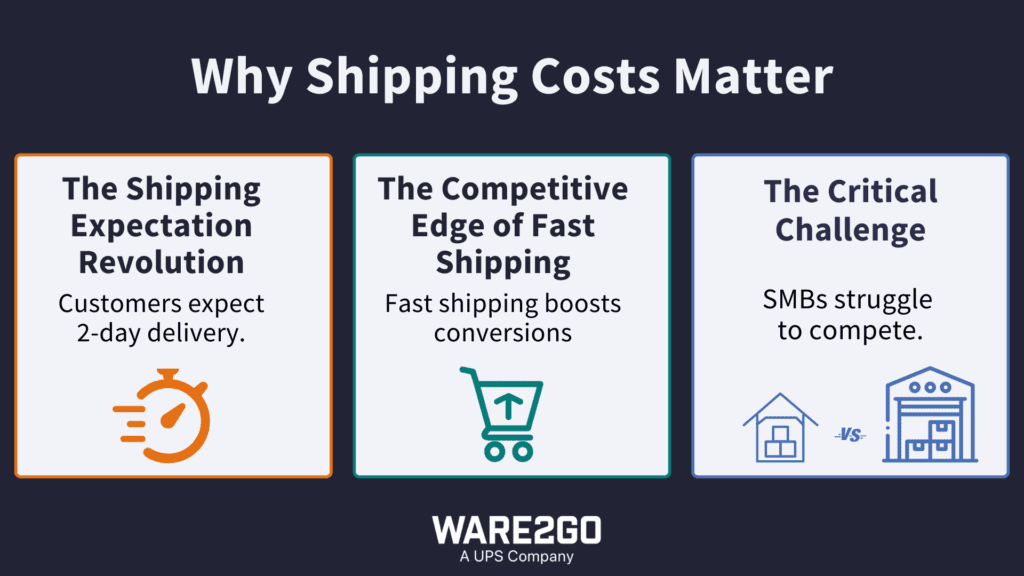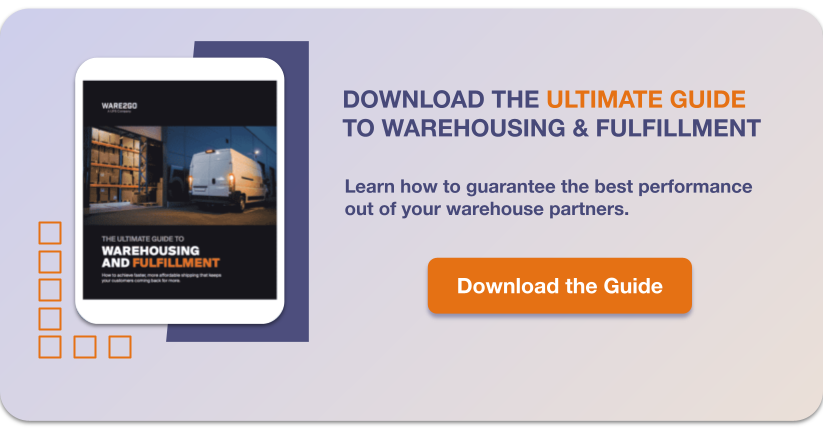Shipping costs can be a significant expense for any business offering fast, free delivery—something customers have come to expect. By optimizing your delivery processes, you can control these costs and identify sizable opportunities for savings without sacrificing customer experience.
Download our guide to optimize warehousing and fulfillment strategies for reduced shipping costs and greater efficiency.
These costs can feel like a slow leak in your business—barely noticeable at first, but they drain your profits over time. As an eCommerce entrepreneur, you’re already juggling product sourcing, marketing, and customer satisfaction.
The last thing you need is unpredictable shipping expenses eating into your bottom line. But here’s the good news: you don’t have to settle for razor-thin margins.
This article will discuss how to reduce shipping costs, proven and actionable strategies you can use, and why it matters.
Why Shipping Costs Matter

In today’s anything, anytime connected world, shipping costs and delivery speed have become make-or-break factors for small and medium-sized businesses (SMBs) across the business-to-business (B2B) and business-to-consumer (B2C) spectrum.
The Shipping Expectation Revolution
Led by Amazon, the largest eCommerce companies have reset shoppers’ expectations for freight costs and delivery time. Sixteen years since the debut of Amazon Prime, large-scale, fast shipping has become standard to the point where 2-day nationwide shipping is expected from all merchants – even SMBs. In fact, 37% of consumers actually expect small to mid-sized merchants to ship faster than their big box competitors.
The Competitive Edge of Fast Shipping
Merchants who prioritize customer expectations for fast shipping have a distinct competitive advantage. 65% of merchants in a recent survey reported an increase in eCommerce cart conversions of up to 25% when they offered a 1-2-day delivery promise. Further, 75% believe that offering 2-day shipping makes them more competitive.
The Critical Challenge
The real question for SMBs is, without the resources and infrastructure of a large-scale enterprise, how can fulfillment operations be streamlined to reduce shipping costs without negatively impacting bottom line profitability?
13 Ways to Reduce Your Shipping Costs

1. Design a Warehouse Network that Gets You Closer to Customers
Shipping fees increase as orders are sent further away. For domestic shipments in the U.S., shipping zones span from Zone 1 to Zone 8. The point of origin is in Zone 1, and zones measure the distance a shipment travels. The higher the zone, the more expensive an order is to ship.
For example, a package sent 2,000 miles through USPS from Seattle to Tulsa would be Zone 8. But the same package sent only 107 miles from Oklahoma City to Tulsa would be Zone 2.
As a result, storing inventory closer to customers will eliminate shipping to higher zones, reduce transportation costs and improve shipping speeds. SMBs should evaluate their fulfillment network, with the goal of identifying optimal warehouse placements across the country based on historical and projected customer demand.
2. Establish Rigorous Packout SOP’s
Having a top-notch packout solution is especially important for SMBs because inventory is typically their largest investment. Protected products arrive in one piece more often, reducing logistics costs and damage complaints.
When hydrogenated water brand HyVIDA found a fulfillment partner that took responsibility for the safe delivery of their product, they saw their Amazon reviews and return rates improve significantly.
Learn more about Ware2Go’s Warehouse SOPs
3. Calculate Dimensional Weight Accurately
Dimensional Weight (of DIM Weight) is the method that freight and postal carriers use to determine shipping prices. Pricing varies by carrier, but the formula always multiplies length, times width, times height.
Making sure DIM Weight of products is accurate on all documentation with a fulfillment provider will give you a more accurate idea of your shipping costs and will also ensure against costly shipping charge corrections.
The calculator below will calculate DIM weight and carrier rates from length, height, width, and package weight.
4. Reduce Dimensional Weight When Possible
No matter the carrier, a greater DIM Weight will always equal higher shipping costs. Assess whether your package could be safely shipped in a smaller box to bring down your per-shipment cost.
Additionally, well-designed custom packaging saves money on package fillers such as packing peanuts, bubble wrap and shredded paper.
5. Switch from Boxes to Poly Mailers
For non-fragile items, poly mailers can cost significantly less per unit than cardboard boxes. They will also have a lower DIM weight, which will reduce shipping costs as well.
There are plenty of options for poly mailers, from padded to eco-friendly, and they can even be custom-printed to build a more personal experience with your brand.
6. Increase Average Order Value (AOV)
Many outsourced fulfillment providers offer economies of scale for multi-sku packouts. This makes each shipment more profitable and offsets per-shipment costs. Three reliable methods for increasing AOV are:
- Bulk discounts: Bulk discounts can increase the average order value by providing customers with a more attractive price point for larger purchases.
- Kitting and bundling: Grouping skus commonly bought together into a convenient kit will increase the likelihood that shoppers will purchase accessories and add-ons.
- Payment options: Most eCommerce platforms offer financing plugins, like Four, through their app store. Flexible payment options like installment plans can encourage customers to make larger purchases by reducing immediate financial barriers.
7. Reduce Return Rates
Reducing return rates decreases shipping costs while encouraging customer loyalty. On the front end, invest in writing accurate, detailed product descriptions and shooting high resolution photos and videos to reduce returns from customers who say the product does not match the image or description.
On the back end, proper warehouse packout procedures are essential for ensuring the safety of products in transit. Damaged items result in costly returns and negative reviews, which hurts brand equity, word-of-mouth, and repeat business.
8. Partner with Third Party Logistics Providers (3PLs) or a Fourth Party Logistics Provider (4PL) to Access Economies of Scale
The enormous resources corporations have at their disposal allow them to easily reduce shipping costs and access the latest technology, transportation, and economies of scale to deliver on 2-day and even same-day delivery.
Unfortunately for SMBs, it is typically less economical to handle their own fulfillment – on top of lacking budgets necessary to access the latest and greatest in technology and transportation.
This is where 3PL providers come in.
These logistics service providers store inventory, pack shipments, and ship packages, taking over the responsibility of fulfilling orders and shipping nationwide. Outsourcing supply chain management improves service levels and bypasses expedited shipping charges, while allowing merchants like children’s toy and furniture provider ECR4Kids to concentrate more time and budget on what they enjoy most – solving problems and delighting customers.
Put another way, 3PLs let sellers spend more time on innovation, sourcing, marketing, and growing their brand instead of worrying about high cart abandonment rates due to expensive shipping fees, or customer complaints about long transport times and damaged goods.
Third-party logistics providers reduce operational complexity and costs by managing distribution and logistics workflows more efficiently. Additionally, 3PLs often have out-of-reach minimums for Average Daily Volume (ADV).
For this reason, small-to-medium-sized businesses in growth mode should consider partnering with a professional fourth party logistics (4PL) fulfillment company that provides nationwide warehousing, inventory management, and eCommerce fulfillment services. This will reduce the operational burden of managing multiple fulfillment solutions and redundant distribution networks, along with reducing logistics and supply chain costs.
Talk to one of our 3PL experts
9. Hybrid Shipping Solutions
Using hybrid shipping solutions, such as UPS SurePost or FedEx SmartPost, can reduce shipping costs while maintaining efficiency for last-mile deliveries. These services leverage major carriers for the main transit and USPS for the final delivery, combining the strengths of both networks.
- Carrier efficiency: Hybrid shipping solutions offer a cost-effective way to balance speed and cost by utilizing major carriers for long-haul transit and USPS for last-mile delivery. This approach is especially useful for reaching residential areas without sacrificing delivery reliability.
- Cost savings: Compared to full-route carrier services, hybrid options can significantly reduce costs, particularly for lightweight or non-urgent shipments. Businesses can save up to 20-30% on shipping expenses depending on volume and destination.
- Use case: Small businesses shipping regionally or domestically can easily integrate hybrid services to optimize costs without compromising service. This is especially valuable for eCommerce companies offering standard shipping for less time-sensitive orders.
10. Prepaid Shipping for Cost Efficiency
Prepaid shipping allows businesses to reduce shipping costs by purchasing labels in advance for consistent shipment volumes. This strategy works well for companies with predictable shipping needs and ensures streamlined processes.
- Cost benefits: Major carriers offer upfront discounts for prepaid labels, allowing businesses to save on shipping costs by committing to a set volume of shipments in advance. These savings can add up quickly for high-frequency shippers.
- Predictability: Prepaid shipping simplifies budgeting by locking in rates ahead of time, protecting businesses from unexpected carrier rate increases and seasonal surcharges. This consistency helps with more accurate cost forecasting.
- Best practices: To maximize cost efficiency, use prepaid shipping for orders with similar sizes and weights. This ensures easier management of labels and avoids complications from unexpected dimensional or weight adjustments.
11. Regional Carriers for Last-Mile Delivery
Regional carriers provide a cost-effective alternative for last-mile delivery by focusing on specific areas or zones. These carriers often offer faster, more affordable solutions for businesses shipping locally or within a region.
- Local expertise: Regional carriers specialize in specific geographic areas and have a deep understanding of local delivery nuances, such as traffic patterns and neighborhood access points, resulting in more reliable service.
- Cost advantages: For short-distance shipping, regional carriers often offer lower rates than national carriers, helping businesses reduce last-mile delivery costs while maintaining high service standards.
- Examples: Industries like retail, healthcare, and food and beverage frequently rely on regional carriers for fast, cost-efficient deliveries, especially for time-sensitive or perishable goods.
12. Use Third-Party Insurance
Third-party shipping insurance providers offer a cost-effective alternative to carrier-provided insurance, allowing businesses to protect shipments while reducing costs. These providers often offer customizable coverage for specific needs.
- Flexibility: Third-party insurance providers allow businesses to customize coverage levels based on shipment value and risk, offering more control and cost savings compared to standard carrier insurance.
- Best practices: Use third-party insurance for high-value or fragile items to ensure adequate protection at a lower cost. Work with providers that offer streamlined claims processes to minimize disruptions and maintain customer satisfaction.
Looking for an insurance provider with the flexibility of a third party and the reliability of an established brand? Click here to learn more about Ware2Go’s partnership with UPS Capital.
13. Implement Real-Time Order Tracking
Providing real-time tracking for orders enhances customer satisfaction and builds trust while helping businesses streamline logistics. This technology also reduces inquiries and improves operational efficiency.
- Customer transparency: Real-time order tracking keeps customers informed at every stage of the shipping process, reducing uncertainty and the risk of loss or porch piracy.
- Logistics efficiency: Tracking data helps businesses proactively identify delivery delays and adjust operations, enabling more efficient route planning and improved carrier performance.
- Integration options: Companies can leverage tracking tools provided by major carriers or integrate third-party solutions with eCommerce platforms for a seamless customer experience and centralized visibility.
How to Calculate Shipping Costs (Step-by-Step)

Calculating shipping costs can be simplified by following these key steps:
Step 1: Determine Package Weight
- Use a postage scale to measure the package’s actual weight accurately.
- Ensure all items, packaging materials, and labels are included when weighing.
- Note: Carriers calculate shipping rates based on actual or dimensional weight, whichever is higher.
Step 2: Measure Package Dimensions
- Measure the package’s length, width, and height in inches.
- Multiply these dimensions to calculate DIM weight using the formula:
- DIM Weight = (Length × Width × Height) ÷ DIM Factor (The DIM factor varies by carrier).
- Note: Dimensional weight is often higher than the actual weight, and carriers charge based on the greater value.
Step 3: Identify the Shipping Zone
- Use the shipping origin ZIP code and the destination ZIP code to find the zone (e.g., Zone 1–8 in the U.S.).
- Carriers like USPS and FedEx offer zone maps for reference.
- Note: The farther the destination, the higher the cost due to increased transit distance.
Step 4: Select the Shipping Speed
- Choose between ground, express, or overnight shipping options based on your customers’ needs.
- Faster delivery speeds (e.g., overnight shipping) are significantly more expensive.
- Why it matters: Shipping speed determines cost and customer satisfaction.
Step 5: Account for Additional Charges
- Check for surcharges, including:
- Fuel surcharges (fluctuate based on fuel prices).
- Residential delivery fees for non-commercial addresses.
- Oversize package fees for unusually large items.
- These fees can significantly increase shipping costs if not accounted for.
Step 6: Use Carrier Shipping Calculators
- Visit carrier websites like USPS, FedEx, or UPS and input package details to get an accurate cost estimate.
- Many eCommerce platforms integrate shipping calculators to streamline this process.
- Automated tools reduce manual errors and provide accurate pricing instantly.
Step 7: Compare Rates Across Carriers
- Compare rates between major carriers and regional carriers for cost-effective options.
- Some carriers offer flat-rate shipping for standardized box sizes, which can help reduce cost variability.
- Why it matters: Identifying the best rate ensures profitability and customer satisfaction.
FAQ About How to Reduce Shipping Costs
Below you’ll find quick and easy answers to your top questions about how to reduce shipping costs.
How do I get shipping prices down?
Reducing shipping prices starts with optimizing your strategy. Consider using hybrid shipping solutions like UPS SurePost or regional carriers for last-mile delivery to cut costs. Negotiate discounted rates with carriers based on your shipping volume, and explore prepaid shipping options for predictable order sizes. Additionally, third-party shipping insurance and real-time tracking tools can help minimize unnecessary expenses while maintaining high service standards.
How can I save money on shipping costs?
To save money on shipping, focus on consolidating shipments and reducing package dimensions to avoid dimensional weight surcharges. Use regional carriers for local deliveries and hybrid services for non-urgent shipments. Implementing a multi-carrier strategy and comparing rates can help you choose the most cost-effective option for each order. Investing in technology like real-time tracking can also prevent costly delays and improve operational efficiency.
What is the cheapest way to ship items?
The most affordable shipping method depends on your delivery timeline and destination. For lightweight, non-urgent shipments, hybrid services like FedEx SmartPost or UPS SurePost are typically the cheapest. For short-distance or local deliveries, regional carriers often provide lower rates than national carriers. Consider flat-rate options for heavier packages to avoid weight-based pricing surprises.
How do I lower my USPS shipping costs?
To reduce USPS shipping costs, take advantage of discounted rates for commercial shippers and explore prepaid shipping options. Optimize your packaging to minimize weight and size, avoiding unnecessary fees. If you ship in bulk, negotiate custom pricing with USPS or integrate regional carriers for part of the shipping process to lower last-mile costs.
Ware2Go: Your Strategic Partner in Shipping Cost Optimization
Your shipping strategy can distinguish between a thriving eCommerce business and a barely scraping by. Every cost-saving move—switching to regional carriers, adopting hybrid shipping methods, or optimizing DIM weight—brings you closer to a stronger bottom line and happier customers.
Ware2Go was created by UPS specifically to address this need and provide affordable 1-2 day delivery coverage nationwide for merchants across various industries in all growth phases.
To learn more about how Ware2Go can help you reduce shipping costs, reach out to one of our shipping optimization experts.




